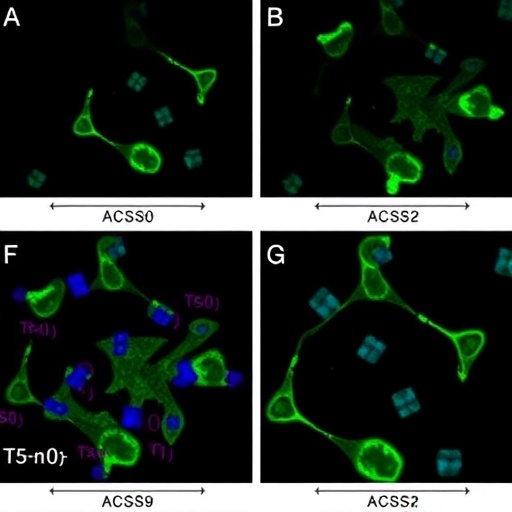In the complex landscape of cellular biology, the interactions between RNA molecules and proteins serve as fundamental regulators of gene expression and myriad cellular functions. Decoding these interactions on a global scale remains a formidable challenge due to the structural diversity and dynamic nature of RNA-protein complexes. Recent advancements herald a transformative leap in this arena: PRIM-seq, a cutting-edge technology designed to simultaneously identify RNA-binding proteins (RBPs) and their associated RNA molecules. This innovative method, introduced by Qi, Xue, Chen, and colleagues, promises to illuminate the intricate web of RNA-protein associations with unparalleled resolution and scale, setting the stage for groundbreaking discoveries in molecular biology and disease research.
PRIM-seq employs a novel strategy that exploits the physical proximity between RNA molecules and protein-linked DNA barcodes, enabling the generation of unique chimeric DNA sequences. Unlike traditional methods that rely heavily on individual antibodies or protein-specific reagents, PRIM-seq achieves de novo identification without prior knowledge of binding partners. This characteristic marks a pivotal shift towards unbiased, high-throughput mapping of RNA-protein interactions. The technology leverages proximity ligation techniques, effectively capturing the spatial co-localization of proteins and RNAs inside the cellular milieu, which are subsequently decoded through deep sequencing, unravelling complex associations at a genome-wide scale.
To demonstrate its robustness, the researchers applied PRIM-seq to two distinct human cell lines, constructing a comprehensive human RNA-protein association network dubbed HuRPA. This vast network encompasses over 350,000 interactions, involving roughly 7,000 unique RNA species and close to 11,000 proteins. Remarkably, among these proteins, 2,610 were each found to associate with at least ten different RNA molecules, underscoring the multifunctional nature of many RBPs. This immense dataset not only broadens our understanding of the RNA-protein interactome but also provides a critical resource for pinpointing key regulatory nodes that influence cellular behavior and disease processes.
One of the standout findings emerging from the HuRPA network was the identification of LINC00339, a long intergenic non-coding RNA (lincRNA) previously tied to tumorigenesis, as having the highest number of protein interactions among RNAs examined. This discovery propels LINC00339 into the spotlight as a central hub of protein interactions, likely coordinating a diverse array of cellular pathways. Experimental validations conducted confirm LINC00339’s status as a bona fide RNA-protein interaction hotspot, suggesting that its abundant protein partnerships may underpin its involvement in cancer progression and cellular regulation.
Beyond lincRNAs, PRIM-seq has unveiled intriguing RNA-binding capacities of proteins not traditionally classified as RNA-binding. The study validated chromatin conformation regulators such as SMC1A, SMC3, and RAD21 as associating with numerous RNAs, highlighting an underappreciated facet of chromatin architecture proteins functioning at the RNA interface. Additionally, metabolic enzyme PHGDH, classically known for its role in serine biosynthesis, was experimentally confirmed to associate with RNA molecules, supporting emerging paradigms where metabolic enzymes moonlight in RNA regulation, linking metabolism and gene expression in novel ways.
The methodological innovations behind PRIM-seq resolve long-standing technical bottlenecks that have limited comprehensive resolution of RNA-protein complexes. PRIM-seq circumvents dependence on individual antibodies, which traditionally constrain the scope to well-known RBPs, enabling discovery of previously unknown RNA-binding functionalities. By physically coupling proteins and RNAs with uniquely barcoded DNA adapters, this approach preserves native interactions and captures a snapshot of dynamic, multifunctional complexes in live cells, thereby providing unprecedented insight into the biology of RNA regulomes across various cell types.
Importantly, the applicability of PRIM-seq extends beyond the initial human cell lines, with potential use in diverse biological contexts including development, stress responses, and disease states. Given RNA’s central role in cellular regulation and the pervasive influence of RBPs in health and disease, this technology opens new possibilities for elucidating post-transcriptional regulation mechanisms at an unprecedented scale and depth. It offers a powerful toolkit to decode the intricate RNA-protein communications that orchestrate biological processes, including the modulation of transcript stability, localization, and translation.
The human RNA-protein association network HuRPA, derived through PRIM-seq, stands as an unprecedented resource not only for understanding basic biology but also for therapeutic research. The vast network facilitates prioritization of candidate RBPs implicated in diseases, including cancer, neurodegeneration, and viral infections, where aberrant RNA-protein interactions are increasingly recognized as key pathogenic drivers. This could accelerate target identification and validation pipelines, ultimately informing the development of novel RNA-targeted therapies.
One compelling example is the role of LINC00339, whose extensive protein associations suggest a multifaceted regulatory capacity potentially exploitable in cancer therapeutics. Similarly, uncovering RNA-binding roles for chromatin regulators like cohesin complex members SMC1A, SMC3, and RAD21 provides a new dimension to understanding how chromatin architecture intersects with RNA biology. These insights may inspire innovative strategies for modulating chromatin and gene expression dynamics through targeting RNA-protein interactions.
Moreover, PRIM-seq’s reliance on sequencing-based readouts democratizes access to comprehensive RNA-protein interaction mapping, eliminating the need for specialized reagents and simplifying experimental workflows. This scalability may fuel expansive datasets, integrated with transcriptomics and proteomics, to form a holistic picture of cellular regulation. Such integrative approaches are crucial for dissecting complex pathologies and identifying biomarkers, enhancing personalized medicine strategies.
The validation of metabolic enzyme PHGDH as an RNA-binding protein is particularly thought-provoking, bridging metabolism and RNA biology. The dual functions of such enzymes could represent evolutionary adaptations enabling fine-tuning of metabolic pathways in response to RNA cues or cellular states. Unraveling these multifaceted interactions will enrich our understanding of cellular homeostasis and adaptability under physiological and pathological conditions.
PRIM-seq’s discovery-driven framework marks an inflection point in RNA biology, shifting focus from canonical RBPs towards an inclusive view embracing diverse proteins and RNAs. Its ability to concurrently profile both molecular partners addresses an unmet need for holistic interactome mapping and paves the way for unveiling complex networks underlying cellular functions. As the method gains traction, it is poised to unlock hidden layers of gene expression regulation and reveal novel interdependencies critical for health and disease.
Looking forward, the wider adoption of PRIM-seq promises to catalyze a surge of discoveries in RNA-mediated regulatory landscapes, extending beyond human cells into model organisms and clinical samples. Coupled with advancing sequencing technologies and computational analytics, it may eventually characterize RNA-protein interactomes across temporal and spatial dimensions, deepening our grasp of cellular complexity. Furthermore, by facilitating rapid identification of RNA-binding proteins without the need for customized reagents, PRIM-seq is positioned to accelerate functional annotation of the proteome under diverse conditions.
In conclusion, PRIM-seq represents a landmark technological advance, elegantly addressing the longstanding challenges of mapping RNA-protein interactions at scale. By generating a dense network of interactions and validating key components such as LINC00339 and cohesin regulators, this method unlocks new layers of biological regulation. Its broad applicability and depth promise to infuse RNA biology with fresh insights, driving forward research into fundamental mechanisms and translational applications alike. As we stand at the convergence of RNA research and proteomics, PRIM-seq offers a powerful lens to decipher the dynamic choreography of molecules that orchestrate life at its most fundamental level.
Subject of Research:
Genome-wide mapping of RNA-protein interactions and identification of RNA-binding proteins and their target RNAs in human cells.
Article Title:
Genome-wide mapping of RNA-protein associations through sequencing
Article References:
Qi, Z., Xue, S., Chen, J. et al. Genome-wide mapping of RNA-protein associations through sequencing. Nat Biotechnol (2025). https://doi.org/10.1038/s41587-025-02780-z
Image Credits:
AI Generated
Tags: cellular gene expression regulationchimeric DNA sequences generationdisease research methodologiesgenome sequencing technologieshigh-throughput RNA-protein analysismolecular biology innovationsPRIM-seq advancementsproximity ligation strategiesRNA-binding proteins identificationRNA-protein complex dynamicsRNA-protein interactions mappingunbiased mapping techniques





